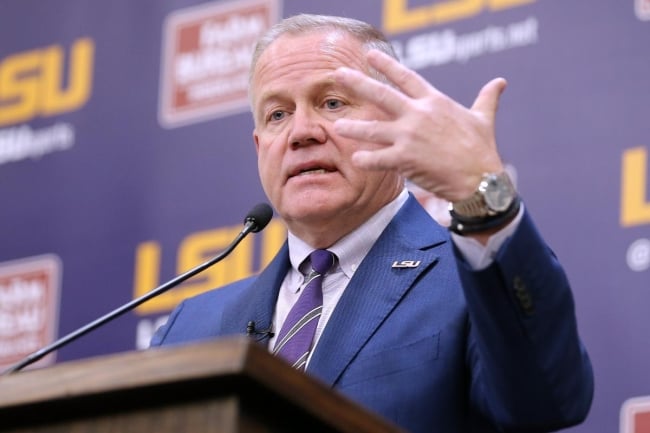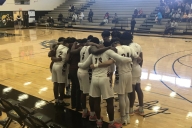You have /5 articles left.
Sign up for a free account or log in.

Brian Kelly is introduced as the head football coach of Louisiana State University.
Getty Images
With the college football season winding down, schools are making the usual moves hiring and firing coaches. But eye-popping numbers have emerged from contracts at three major programs where football coaches are set to earn salaries that outpace some of their NFL counterparts.
At Michigan State University, second-year head coach Mel Tucker signed a contract extension worth a reported $95 million over 10 years. Likewise, Brian Kelly, making the jump from Notre Dame University to become head coach at Louisiana State University, signed a deal worth at least $9 million a year for 10 years. And while the private University of Southern California chose not to release contract details for newly hired Lincoln Riley, the former University of Oklahoma coach is believed to be earning more than the roughly $7.6 million annual salary at his last job.
To some in higher education, these massive deals are cause for concern.
Kim Wilcox, chancellor of the University of California, Riverside, and former provost at Michigan State, called the $95 million Tucker contract extension an “embarrassment” when speaking with reporters and other top college administrators during a Dec. 1 panel discussion on higher education.
“It sends a message about universities broadly that is just really unfortunate and, I think, sets us back,” Wilcox said, adding that such big-dollar deals suggest that universities are irresponsible.
But other observers see the big payouts as business as usual when it comes to college athletics.
“From a finance and economics perspective, all that’s happened is revenues are going up, and coaches contribute to an activity that’s making more money,” said Rodney Fort, a professor of sports management at the University of Michigan. “The competitive process brings part of that to them in terms of higher pay. It’s the way it’s always happened—it’s the way it’s always going to happen.”
The Evolution of Big-Time Coaching Contracts
The increasing commercialization of college athletics over the years has led to a flood of money for major programs, particularly those with top-flight football and men’s basketball teams.
Looking at the historical context, early contracts for gridiron legends were more comparable to what humanities majors make today than to what current football coaches earn. For example, Bobby Bowden signed his first contract at Florida State University in 1976 for $37,500. Nearly two decades later, Bowden signed the first million-dollar college coaching deal, with incentives, in 1995. Not to be outdone, cross-state rival University of Florida gave Steve Spurrier nearly $2 million a year in 1997.
Since the first million-dollar deal, coaching salaries—and college athletics revenues—have continued to climb, driven by growing commercialization and major broadcasting deals. Understanding these contracts requires looking beyond the field of play.
“I think there are some interesting market forces that are causing this to happen,” said Richard Southall, director of the College Sport Research Institute at the University of South Carolina. “With the renegotiation of contracts on the conference level and with the impending expansion of the college football playoffs, athletic departments don’t want to be left behind, so to speak.”
Though nothing official has been announced, many observers and fans expect the college football playoffs to expand from four teams to as many as eight or 12 participants.
According to 2019 figures from the Knight Commission on Intercollegiate Athletics, $2.6 billion flowed into universities from a mix of NCAA and conference distributions, earnings from media rights, and postseason football payouts. By comparison, in 2005, the earliest year for which the Knight Commission has data available, that same source of revenue added up to $641 million. Those numbers apply to schools in the Football Bowl Subdivision, meaning only colleges with upper-level Division I football programs are included in revenue calculations for that data set.
“The college football playoffs and March Madness are the giant contributors in media,” Fort said. “The regular-season media contracts are no slouch. But the payoffs that come from the college football playoffs are large in absolute value, and the same with March Madness.”
Introduced in 2014, the four-team college football playoffs for the FBS have meant multimillion-dollar payouts for the conferences of qualifying teams, which are then distributed to members.
“The college football playoffs brought a new infusion of cash. There was kind of a series of cascading events, which has concentrated power and money in the big-time programs,” said Michael Leeds, an economics professor at Temple University with research interests in sports.
Though the vast majority of universities can’t afford to offer massive coaching contracts, Leeds speculates there may be some ripple effects in salaries to keep good coaches from getting poached, even among the less visible programs outside the big-name Power Five conferences: the Atlantic Coast Conference, Big 12, Big Ten, Pac-12 and Southeastern Conference.
“If you are in a non–Power Five conference, if you want to keep your coach, or at least make sure he doesn’t jump at the first opportunity, you’re going to have to raise your pay,” Leeds said.
Academics vs. Athletics
Big-time college athletics requires an essential ingredient: unpaid labor. Student athletes bring value to their programs, money that ultimately goes into the pockets of their coaches. And while students can now cash in on name, image and likeness contracts, they are still barred from directly accepting payments for their performances as NCAA athletes.
“They help the team win, and when the team wins it generates more revenue, so each of these athletes has a value that they produce,” said Andrew Zimbalist, an economics professor at Smith College and president-elect of the Drake Group. “Since the NCAA does not allow them to be directly compensated in cash, coaches end up getting the value that the athletes create.”
The Drake Group was formed in 1999 due to concerns about academic corruption in college athletics.
“We were concerned about the commercialization of college sports and how that was negatively impacting the educational environment and educational experience of student athletes,” Zimbalist said. “We stand for the principle of academic integrity, restoring academic integrity in our sport.”
Zimbalist said students are only required to meet bare minimum standards for eligibility and suggests that the NCAA uses creative math to calculate high graduation rates for athletes. He feels “that there’s been a gradual drift away from doing serious education for student athletes.” He adds that the revenue focus of athletics ultimately detracts from institutional missions.
“This thing has taken on a life of its own,” he said. “Unfortunately, many Division I universities, particularly state schools, have gone into the business of producing college football rather than college education, and the football coach is the most important person on campus.”
Such spending, he said, is justifiable on neither economic nor ethical grounds. But other observers say athletic departments are by and large entertainment entities that extend from colleges.
“A number of students go to big-time colleges and universities to consume college sports as part of their collegiate experience,” Southall said. “And when I talk about a collegiate experience, that includes going to class and having access to an education, but it’s also a social experience.”
Athletics also hold an important position as the so-called front porch to an institution, an outward-facing brand that can catch the attention of prospective students. Such is the case at Michigan State, LSU and USC, Southall said, where the ink is barely dry on massive coaching deals.
“Those institutions positioned athletics as a major part of their institutional branding of the university over all,” Southall said. “It is not surprising to me that the salaries have escalated a bit, but the role in which the coaches are playing ties in perfectly with the way athletics has been used as a marketing and public relations tool for these universities.”
Congressional Appetite for College Athletics Reform
Blockbuster deals signed by college coaches have not gone unnoticed in Congress.
“Professional-level payouts for college coaches are only possible because colleges and the NCAA illegally collude to directly restrict compensation for the mostly Black athletes so that the mostly white coaches and industry executives get to keep all the profits for themselves,” Democratic senator Chris Murphy of Connecticut said in a Nov. 30 statement. “That’s shameful.”
Likewise, Senator Richard Blumenthal, also a Connecticut Democrat, told USA Today that recent contracts such as those at Michigan State, LSU and USC are “outrageously astronomical.” He added that college sports reform was a topic that could possibly be raised in Congress in 2022.
Experts suggest that substantive college athletics reform in Congress is probably a long shot for the short term.
“I don’t see anything substantial happening in Washington,” Leeds said. “Maybe some window dressing, but nothing that’s going to alter the basic business model” of big-time college sports.
However, Leeds does see two possibilities that could change how college coaches get paid. The first, he said, is if athletes are able to demand and earn compensation for their play beyond the outside money they earn from name, image and likeness rights, which would likely require a battle in the courts. The second, he said, would have to involve an unlikely collapse of TV revenues that prop these athletic departments up.
In the meantime, Leeds said it’s hard to say where colleges will draw the line on coaching salaries: “Every time I have said it can’t possibly go any higher, I’ve been proven wrong.”








